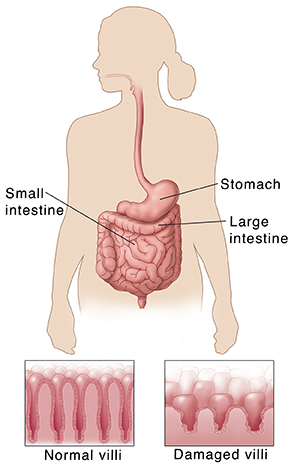Celiac Disease
Celiac disease is caused by an immune-based reaction to gluten in food. Gluten is a protein found in many grains such as wheat, barley, and rye. Celiac disease affects tiny, fingerlike stalks (villi) in the small bowel (intestine). Normally, the villi make it possible for the small bowel to absorb nutrients from the food you eat. But celiac disease damages the villi. So you can't absorb the nutrients you need. Celiac disease is an autoimmune disease. You can manage the disease by removing gluten from your diet. This relieves your symptoms. It also reverses the damage to your small bowel. Celiac disease is sometimes called celiac sprue.
 |
| With celiac disease, villi inside the small intestine become damaged and cannot absorb nutrients properly. |
Causes of celiac disease
Celiac disease may have a genetic component. This means it can be passed down by family members. If your healthcare provider thinks that you have celiac disease, they may advise that other members of your family be checked for it as well.
Symptoms of celiac disease
The symptoms of celiac disease can vary for each person. Some people have no symptoms at all. If symptoms do happen, they can include:
-
Diarrhea, constipation, or both
-
Light-colored, foul-smelling, or fatty stool
-
Belly pain and cramping
-
Belly swelling or bloating
-
Weight loss
-
Bone or joint pain
-
Iron deficiency
-
Headaches
-
Tiredness and loss of energy
-
Mood changes, irritability, and depression
-
Infertility
-
Unexplained elevated liver test (enzymes)
-
Canker sores
-
Skin rash
-
Tooth enamel problems
Diagnosing celiac disease
Your healthcare provider will ask about your symptoms and health history. You’ll also have a physical exam. Tests are then done to confirm the problem. These can include:
-
Blood tests. These help check for specific proteins in the blood that are present with celiac disease. They also check for anemia and help rule out other problems. The tests are done by taking a blood sample.
-
Upper endoscopy with biopsy. This is done to see inside the stomach and duodenum (first part of the small bowel). For the test, an endoscope is used. This is a thin, flexible tube with a tiny camera on the end. It’s inserted through the mouth and down into the stomach and duodenum. Tools are passed through the endoscope to remove tiny tissue samples (biopsy). The tissue samples are taken to a lab and looked at under a microscope. This is to check the tiny villi for damage. This test must be done while you are still eating food with gluten. This is the only way to see if gluten is damaging the villi.
-
Capsule endoscopy. For this test, a tiny camera the size of a big pill gets swallowed. It passes through the small intestine, taking pictures that get evaluated for intestinal damage from celiac disease.
-
Genetic tests. These check for problems with certain genes linked to celiac disease. They are done by taking blood samples.
Treating celiac disease
To treat celiac disease, you must remove all sources of gluten from your diet. This will allow the villi to heal so that nutrients can be absorbed normally. It’s important to follow a strict, gluten-free diet daily, even if you don’t have symptoms. If you don’t do this, the small bowel can become permanently damaged, which can lead to serious health problems. These include bone disease, cancer of the small bowel, and various nervous system disorders. You may need to take certain vitamins if your levels are low. Your healthcare provider may want to recheck your intestine with an upper endoscopy or repeat the celiac blood tests to make sure the tissue has healed.
Sources of gluten
Gluten is found in wheat, barley, and rye. The most common foods with gluten are those made with wheat flour. These include bread, pasta, cake, and cereal. Gluten is also often found in beer, gravies, salad dressings, and most packaged foods. It's even found in some nonfood products, such as certain medicines and cosmetics. Your healthcare provider can refer you to a dietitian to counsel you about what you should avoid. The resources below will also give you lists of foods and products that contain gluten.
Follow-up
You’ll meet with your healthcare provider from time to time to monitor your health. During these visits, routine blood tests are often done to make sure your condition is under control. Your healthcare provider can also refer you to other providers or support and advocacy groups to help you cope with your condition. Online resources can tell you how to manage your condition day to day. This information could include recipes, restaurants that have gluten-free options, and grocery stores that offer a good selection of foods. A dietitian can help you make a diet plan that's appropriate and safe.
To learn more
The following resources can help you learn more about celiac disease and how to manage it:
-
Celiac Disease Foundation
-
National Celiac Association
-
Gluten Intolerance Group
-
National Institute of Diabetes and Digestive and Kidney Diseases